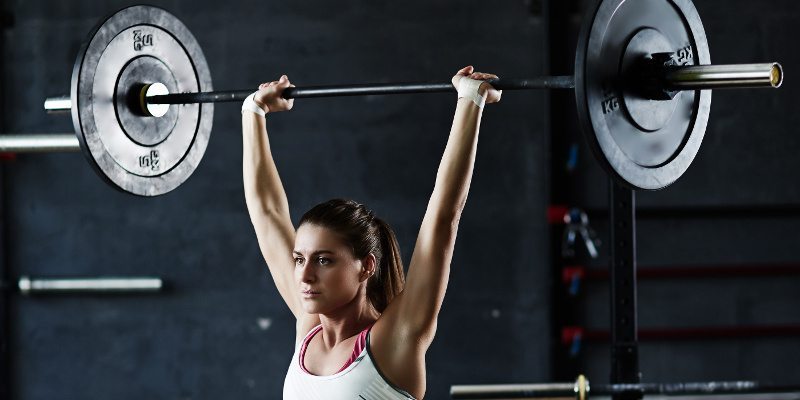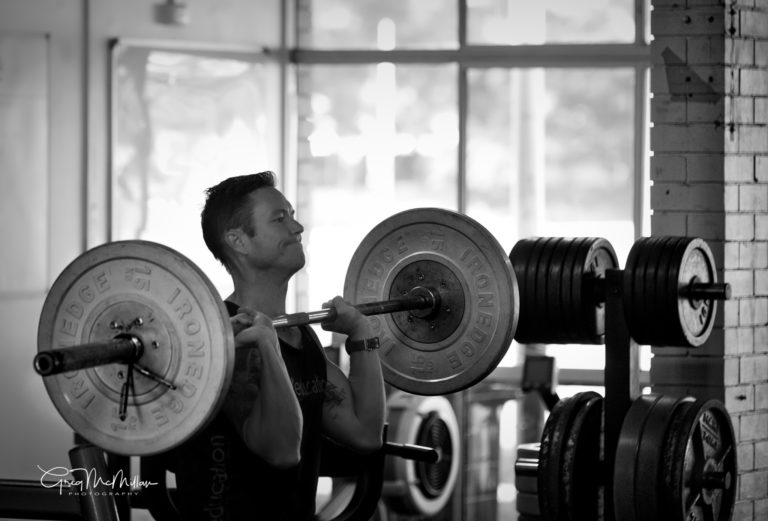The Standing Barbell Shoulder Press is a full body, compound exercise. The shoulders and arms press the weight over head while the legs, lower back and abs provide balance.
- Stand with the bar resting on the front shoulders with hands next to shoulders.
- Press the bar over head, until it’s balanced over the shoulders and mid-foot
- Lock the elbows at the top, and shrug the shoulders to the ceiling.
How to Properly Perform a Barbell Shoulder Press
To avoid shoulder pain, press with a narrow grip so you don’t flare your elbows. Press the bar over your head, lock your elbows and shrug your shoulders towards the ceiling. This engages your traps and prevents shoulder impingement.
Start with your stance.
Place your heels hip-width apart, ensuring your feet are flat on the floor, slightly pointed out.
Next, focus on your grip.
Achieve a full grip with the bar in the base of your palm, located close to your wrists. Remember to squeeze the bar.
After getting a firm grip, adjust your grip width.
Maintain a narrow grip just outside of your shoulders.
Now pay attention to your wrists.
They should form a straight line from the bar to your wrist to your elbow. Make sure not to let your wrists bend back to avoid pain.
Moving on to your elbows.
They should be in front of the bar from a side view and about 45° in from the front. Avoid flaring.
Consider your forearms next.
They should be vertical to the floor from all angles: perpendicular from both the side and front views.
Then, check your upper-arms.
They shouldn’t be parallel to the floor because this isn’t a front squat. Make sure your forearms remain vertical.
Switch focus to your shoulders.
Aim to hold the bar on your front shoulder muscles and try to shrug your shoulders to the ceiling.
With regard to your chest.
Try to lift it by arching your upper back. Strive to touch your chin with your upper chest.
For your upper-back,
you should arch it to lift your chest up, but don’t squeeze your shoulder blades.
Next, focus on your traps.
Shrug them at the top. Lockout the bar by shrugging your shoulders to the ceiling.
Now let’s talk about your head.
Keep it neutral. Look forward and refrain from looking at the ceiling or the bar while you press.
As for your lower back,
keep it neutral as well. Avoid over-arching and hyper-extending your lower spine.
Look at your torso next.
Lean slightly back at the bottom, but move forward at the top. Once again, don’t over-arch your lower back.
On the way up, press the bar in a vertical line. Stay close to the bar by moving your torso forward at the top.
At the lockout, hold the bar over your shoulders. Shrug your shoulders to the ceiling and lock your elbows.
On the way down, lower the bar to your shoulders. Do it under control but not too slowly. Avoid flaring your elbows.
As for breathing, inhale at the bottom before you press. Hold your breath at the top and exhale at the bottom.
Pay attention to the bar path. Press the bar in a vertical line from your shoulders over your head, ensuring it ends above your shoulders.
In between reps, exhale, raise your chest, align your forearms vertically, take a big breath, and then press again.

Muscles Worked
The Overhead Press works your whole body. Your shoulders and arms are the prime movers to press the weight over head. But everything between the floor and your shoulders must stay tight to balance you and the bar. This makes the Overhead Press a full body exercise that works several muscles at the same time with heavy weights.
- Shoulders. You must raise your upper-arms to lift the bar when you Overhead Press. This works your shoulder muscles: your front, side and back deltoid. It develops these three muscle heads evenly with heavy weights.
- Arms. You must straighten your elbows to press the weight overhead. This works the triceps. Your forearm muscles also work to hold the bar.
- Rotator Cuff. Balancing bar overhead works the small muscles that cover you shoulder-blades: surpraspinatus, infraspinatus, teres minor and subscapularis. These rotator cuff muscles stabilize your shoulders. Strengthening them protects your shoulders.
- Trapezius. You must shrug your shoulders at the top of each rep to avoid shoulder impingement. This tilts your shoulder-blade to the side. It creates space for your rotator cuff tendons. Shrugging works your trapezius muscles on the side of your neck.
- Abs. Your core muscles stabilize your body while your shoulders and arms press the weight overhead. They keep you from collapsing under the bar. This strengthens your abdominal muscles, obliques and lower back.
- Legs. Your legs balance your body while your shoulders and arms press. This works your hips, thighs, calves and ankles.

Common Mistakes
Excess Arching
Keep the lower back in neutral spine when you Standing Barbell Shoulder Press. Try not to lean back when pressing the weight. Extreme arching of the lower spine (hyper-extension) squeezes the spinal discs from the back. Note that you should lean back when you Overhead Press. This moves your head out of the way of the bar. It allows you to press in a vertical line which is more effective. But this lean back must come from your hips. Keep your lower back neutral while moving your hips forward.
Bent Wrists
Overhead Pressing with bent wrists hurts and is ineffective for lifting big weights. The goal is to hold the bar close to your wrists, on top of your forearm bones. This stops the bar from hurting your wrists by stretching them beyond their normal range of motion. It also makes the weight easier to press because your vertical forearms can press directly into the bar.
Elbows Back
Some Overhead Press with their elbows behind the bar. Move your elbows forward. They should be slightly in front of the bar so your forearms are vertical.
Check out these other resistance training exercises:
- Face Pull
- Bench Press
- The Turkish Get Up
- Front Squat.
- Shoulder Press – Standing Barbell
- Deadbug – Abdominal Exercise
- Overhead Barbell Squat
- Battle Rope
Learn more about resistance training the Cert 3 in Fitness, Cert 4 in Fitness,and Diploma of Fitness Courses.
